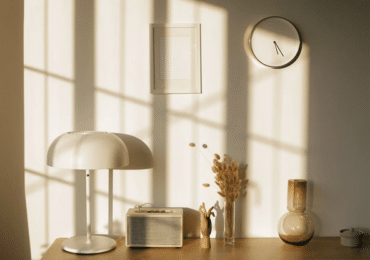Welcoming natural light into your living space can transform your home into a warm and vibrant sanctuary. However, effectively controlling the influx of this natural light is key to maintaining a balanced and comfortable atmosphere. This guide will provide you with insightful and practical tips on how to regulate natural sunlight in your home.
By understanding the dynamics of sunlight, and learning how to use window treatments, mirrors, and the color palette effectively, you can dramatically enhance the ambiance of your living space. Let’s embark on this enlightening journey towards creating a home that is not only aesthetic but also energy-efficient and mood-enhancing.

Understanding the Sun’s Path
The first step in controlling natural light is to understand how the sun moves in relation to your home. This will help you anticipate sunlight at different times of the day and plan accordingly. Even if you opt to purchase new shutters or blinds from https://www.shuttercraft.co.uk or your local store, you should still become more familiar with the sun’s patterns. The direction and angle of sunlight in your home will depend on the time of day and season, as well as the window orientation.
The changing daylight hours during winter and summer can be quite drastic, so it is important to take note of how areas of your living space are affected throughout the year. By mapping out the sun’s path, you can better anticipate its movement and make more informed decisions about window treatments.
Window Treatments
Use blinds, curtains, and shades to regulate sunlight. These can be adjusted throughout the day to control the intensity and direction of light entering your home. Shutters and shades offer excellent insulation against temperature fluctuations, while curtains can be used to diffuse light in a way that is gentle on the eyes. Use lighter fabrics when looking for curtains as this will allow more natural light into your living space. Vertical blinds are also an ideal choice if you need to block out direct sunlight during the hottest part of the day. Moreover, opt for window treatments that will not only benefit the light flow in your home but also add to the style of your space.
Use of Reflective Surfaces
Mirrors, in particular, can be strategically placed to bounce sunlight around a room, thereby enhancing illumination in areas that may not directly benefit from window light. Metal fixtures and glossy furniture can also serve as reflective surfaces, adding an element of brightness to your space. Incorporating such reflective elements near windows can effectively double the amount of sunlight you receive. This subtle reflection also adds an illusion of depth and space, making rooms appear larger and more airy.
However, it’s essential to balance the use of these reflective surfaces to avoid overwhelming brightness. Correctly positioning your mirrors and other reflective items will help you achieve the optimal light balance, thus promoting a lively and inviting atmosphere in your home.
Color Scheme and Light
Lighter colors on walls, ceilings, and floors can reflect sunlight, brightening your space. Conversely, darker shades absorb light, creating a calming, subdued atmosphere. You can embrace a mix of both hues in your home to achieve the desired ambiance. Choose lighter colors on walls that receive direct sunlight, as this will help reflect the light around the space. Darker tones are more appropriate for areas like bedrooms and offices, where you may want to reduce the amount of light entering from windows.
Ultimately, by understanding how color affects natural light, you can create a more beautiful and inviting atmosphere in your home. Furthermore, the use of light and color can also help you reduce your energy consumption.
Utilize Translucent Materials
Translucent materials, like frosted glass, can filter and diffuse harsh sunlight, creating a soft, soothing glow. Such materials can be used for windows and doors, or even as partitions and walls. Consider installing a translucent screen over your windows to reduce direct light and still allow natural light to flow into the space. This way, you will be able to enjoy the benefits of both bright and soft illumination in your home. Translucent materials also add an element of privacy while allowing views from both sides of the window.
For example, if you are looking to enjoy a more open feel in your living room, try using frosted glass on the windows or walls. On the other hand, if you need more privacy, install a translucent film over your windows.
Incorporate Plants
Certain houseplants can filter sunlight while adding a natural touch to your home. Besides being aesthetically pleasing, some houseplants can also help purify the air. Incorporating potted plants into your living space is a great way to reduce glare and harsh sunlight without compromising on natural light. The leaves of these plants act as tiny sunshades, diffusing strong sunlight in order to create an inviting atmosphere that is both calming and energizing. Plants like the Boston fern, Peace lily, and Spider plant are especially known for their ability to filter sunlight. If you have an outdoor living space, consider adding a few trees and shrubs to reduce the amount of direct sunlight entering your home.

Smart Use of External Structures
Canopies, pergolas, and awnings can provide shade and reduce sunlight during the hottest part of the day, keeping your home cooler. Install these structures in areas that receive direct sunlight to effectively shield your home from harsh rays. Make sure they are designed in such a way that they still allow some sunlight into the area, but with softer and more pleasing illumination. In addition to providing shade, external structures can also add a unique design element to your outdoor living space.
If you need additional protection from rain or snow, you can opt for awnings and other retractable covers. By incorporating these structures into your outdoor design, you will be able to enjoy the benefits of natural light while providing enough protection from its intensity.
Energy-Efficient Solutions
These not only reduce heat gain during summer but also trap warmth during winter, maintaining a comfortable indoor environment all year round. Moreover, energy-efficient windows also help reduce noise pollution in your home. High-performance glazing materials are designed to provide superior insulation while also allowing maximum natural light into the space. If you are looking to save on energy costs and create a more inviting atmosphere in your home, upgrading your windows may be the best option. With the right combination of window treatments and high-performance glazing materials, you will be able to enjoy the benefits of natural light while taking advantage of energy-efficient solutions.
With these tips for controlling natural light in your home, you can create a comfortable living space that is filled with warmth and brightness. When used correctly, natural light can make any room appear larger and brighter while also reducing your energy costs. By employing the right combination of strategies, you can effectively balance sunlight and make your home look beautiful and inviting. Natural light is one of the major elements that can enhance your home’s beauty, and with these tips, you will be able to take full advantage of its benefits.

